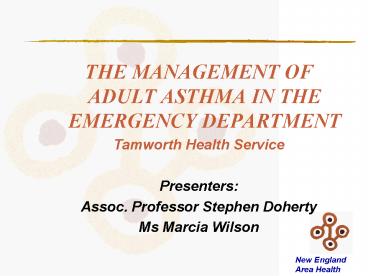THE MANAGEMENT OF ADULT ASTHMA IN THE EMERGENCY DEPARTMENT - PowerPoint PPT Presentation
1 / 16
Title:
THE MANAGEMENT OF ADULT ASTHMA IN THE EMERGENCY DEPARTMENT
Description:
Registered Nurse Emergency Department. Junior Resident Medical Officer. Consumer Representative ... oingoing education to nursing and medical staff on ... – PowerPoint PPT presentation
Number of Views:343
Avg rating:3.0/5.0
Title: THE MANAGEMENT OF ADULT ASTHMA IN THE EMERGENCY DEPARTMENT
1
- THE MANAGEMENT OF ADULT ASTHMA IN THE EMERGENCY
DEPARTMENT - Tamworth Health Service
- Presenters
- Assoc. Professor Stephen Doherty
- Ms Marcia Wilson
2
Team Members Role
- Assoc. Prof Stephen Doherty Emergency Physician
- Ms Marcia Wilson Quality Manager
- Dr Simon OConnor Respiratory Physician
- Dr Nick Ryan Director Emergency Department
- Ms Kate Laurie CNC Respiratory Services
- Ms Verity Treeve NUM Emergency Department
- Registered Nurse Emergency Department
- Junior Resident Medical Officer
- Consumer Representative
3
Mission Statement
- To increase compliance with the National Asthma
Council Guidelines in the management of adult
asthma in the Emergency Department. - To achieve an 80 compliance rate within a seven
month period (February 2003) focusing on
appropriate assessment, investigations,
medications and asthma management plans as
outlined in the NAC Guidelines.
4
Customers and Their Expectations
- PATIENTS
- Uniform assessment
- Appropriate treatment
- Asthma management plan
- Asthma education
- Referral to asthma education
- HEALTHCARE PROVIDERS
- Increased knowledge of NAC Guidelines
- Uniform patient assessment
- Medication management in line with NAC Guidelines
- Education in use/interpretation of spirometry
5
Diagnosis of the Problem
- Phase 1 Indicators of Appropriateness for NSW
Area Health Services Report (May 2001)
indicated NEAHS has higher than State average
separation rates for asthma. - TBH Emergency Department medical record
documentation audit (August 2002) poor
compliance with NAC Guidelines. - 2000/01 there were 699 asthma (all ages)
presentations to ED with 30 of these patients
admitted. - Appropriate equipment available within the ED but
not being utilised during the assessment stage
6
Pareto Chart Base Line ED Records Audit
7
Prioritising the Information
- A second brainstorming session was undertaken by
the multidisciplinary team to identify current
processes in place for the management of adult
asthma in the ED. - Cause effect diagram constructed from the
processes identified to have contributed to
non-compliance with NAC Guidelines. - Multivoting session conducted to prioritise the
causes of non-compliance with the Guidelines to
assist with the planning of interventions and
strategies for implementation.
8
Cause and Effect Diagram
9
Pareto Chart Results from Multivoting
10
Interventions Chosen
- Develop uniform assessment tool based on NAC
Guidelines and educate healthcare providers re
use. - Display laminated copies within the ED
- Provide education to all staff on use and
interpretation of spirometry. Include in Junior
Medical Officers education program. - Provide oingoing education to nursing and medical
staff on the use of the NAC Guidelines. - Include asthma education and the NAC Guidelines
in the JMO education program each term.
11
The Impact
- A follow up ED medical record audit was
undertaken (January 2003) using the same
assessment criteria from baseline audit (August
2002). - Results indicated a marked improvement in
- the uniformity of assessment
- spirometry usage
- pulse oximetry
- appropriate medications
- By combining the rate of spirometry and peak flow
measurements a compliance rate of over 80 with
NAC guidelines was achieved (initial project aim)
12
The Impact
13
Statement of Results
- Demonstrated increased compliance with the NAC
Guidelines for the management of adult asthma in
the ED as evidenced by ED record audit criteria - Uniformity of assessment (57 to 100)
- Spirometry (8 to 83)
- Pulse oximetry (92 to 100)
- Salbutamol (70 to 100)
- Steroids (57 to 100)
- Management plan (28 to 66)
- Development and implementation of a uniform
assessment tool based upon best practice evidence
as articulated in the NAC Guidelines. - Asthma Clinical Pathway developed and currently
being trialled in two facilities includes a
management plan.
14
Evidencing the Improvements
15
Sustaining Improvement
- Conduct 6 monthly ED record audits to monitor
compliance with the NAC Guidelines. - Report results to appropriate committees for
analysing any variances and recommending
appropriate interventions for continual
improvement. - Review JMOs Education Program annually to ensure
asthma education continues to be included. - With the recent recruitment of a Clinical Nurse
Educator to the department, orientate to the
project and ensure ongoing education is attended
for the medical and nursing staff.
16
Future Plans
- Increase the development and utilisation of
asthma management plans. - Evaluate the clinical pathway currently being
trialled prior to further implementation. - Develop clinical pathway into ARMs teleform
format (minimum data sets) - Analyse and act on results of data from clinical
pathway variance - Promote the improvements in efficiency and
standardisation of care, to enable the outcomes
achieved from this project to be replicated
throughout the Area Health Service.































